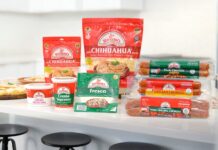SILVER SPRING, Md., July 16, 2019 /PRNewswire-HISPANIC PR WIRE/ — Fresh fruits, vegetables, and juices are especially delicious in the summertime. The U.S. Food and Drug Administration reminds you that safe handling of produce and fresh-squeezed juice is important because these foods are often consumed raw. Some foodborne disease-causing germs multiply faster in warm weather – making food safety more important as temperatures rise.

Learn more:
https://www.fda.gov/food/buy-store-serve-safe-food/selecting-and-serving-produce-safely
https://www.fda.gov/food/buy-store-serve-safe-food/what-you-need-know-about-juice-safety
To prevent food poisoning (also called foodborne illness) and keep nutritious produce and fresh-squeezed juices safe, follow these food safety tips:
Buy Right
- Purchase produce that is not bruised or damaged.
- When choosing pre-cut or fresh-cut produce (such as a half a watermelon or bagged salad greens that have been cut), choose items that are refrigerated or on ice.
- Keep bagged produce separate from raw meat, poultry, and seafood in your cart and shopping bags.
Wash Thoroughly
- Wash produce under running water before eating, cutting, or cooking, and dry with a clean cloth towel or paper towel to further reduce disease-causing germs that may be present.
- Even if you plan to peel a fruit or vegetable, wash it first so dirt and disease-causing germs aren’t transferred from the outside to the inside.
- Scrub firm produce, such as melons and cucumbers, with a clean produce brush.
- For pre-packaged produce, read the label – if it says pre-washed and ready-to-eat, you can use it without further washing.
Prevent Cross Contamination
- Always wash hands before and after preparing food!
- Wash cutting boards, dishes, utensils, and countertops with soap and hot water between the preparation of raw meat, poultry, and seafood and the preparation of produce that won’t be cooked.
- When using plastic or non-porous cutting boards, wash them in the dishwasher after use.
Prepare Safely
- Cut away damaged or bruised areas on fresh fruits and vegetables before preparing and/or eating.
- Discard produce if it looks rotten.
Store Properly
- Keep perishable fresh-cut produce in a clean refrigerator at 40° F or below.
- In the refrigerator, store raw meat, poultry, and seafood so that their juices can’t leak onto produce. Always refrigerate produce that is bought pre-cut or peeled.
Check Your Juice
- Young children, older adults, pregnant women, and people with weakened immune systems (such as transplant patients and individuals with HIV/AIDS, cancer, or diabetes) risk serious illnesses or even death from drinking juices that haven’t been pasteurized or otherwise treated to control disease-causing germs.
- Look for pasteurized or otherwise treated products in your grocers’ refrigerated sections, frozen food cases, or in non-refrigerated containers, such as juice boxes, bottles, or cans.
- Untreated juices sold in refrigerated cases of grocery or health food stores, cider mills, and farmers’ markets must contain a warning label showing that the product has not been pasteurized. Warning labels are not required for juice or cider that is fresh-squeezed and sold by the glass. If you are unsure if a juice product is pasteurized – be sure to ask!
Contact: Media: 1-301-796-4540 Consumers: 1-888-SAFEFOOD (toll free)
Logo – https://mma.prnewswire.com/media/585467/US_Food_and_Drug_Administration_Logo.jpg
SOURCE U.S. Food and Drug Administration







